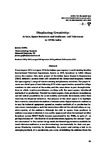Displacing Creativity: Artists, Space Scientists and Audience-Led Television in 1970s India
| dc.contributor.author | Griffin, Joanna | |
| dc.date.accessioned | 2018-01-29T12:10:32Z | |
| dc.date.available | 2018-01-29T12:10:32Z | |
| dc.date.issued | 2017-11-21 | |
| dc.identifier.issn | 2082-6710 | |
| dc.identifier.issn | 2082-6710 | |
| dc.identifier.uri | http://hdl.handle.net/10026.1/10679 | |
| dc.description | AVANT, Vol. VIII, Special Issue ISBN: 978-83-944622-04-6 avant.edu.pl/en DOI: | |
| dc.description.abstract |
From August 1975 to August 1976 the Indian space agency's world-leading Satellite Instructional Television Experiment, known as SITE, broadcast to 2,400 villages across the country. This early project of the Indian Space Research Organisation (ISRO) defined a societal remit still considered the formational imaginary behind the space agency's range of remote sensing and planetary activities. The paper focuses on a brief span of time following SITE when opportunities opened for village residents to take control of the media, and this came about in part through initiatives in which creative practitioners working with the space agency introduced methods of co-production. The shift in creative agency from producers to audiences carried radical possibilities for social mobility and locally determined, rather than state-led, development initiatives. The purpose of this short paper is to highlight how creativity coincided with audience-led innovation. Opportunities for audiences to use the technical equipment opened as creative methods of co-production became more commonplace, such that innovation reflected the cultural values, or cognitive matrix, of the audience. Although the shift in agency from producer to audience was unprecedented, it was swiftly suppressed when the national satellite broadcast system INSAT finally became operational in the 1980s, in spite of-or perhaps because of-this flourish of social innovation. Applying the concept "cognitive innovation" to this context foregrounds the limited opportunities available for rural television audiences to use the technology instrumentally for their own purposes. Displacing creativity, by dismantling the project and putting a halt to its emerging methods of co-production, was a way of delinking the audience from the technology and thereby imposing a different order. By indicating how creative activity accesses cognitive innovation, the paper introduces the notion of "displacing Creativity" as a transferable measure of agency. It argues that where creativity is displaced, crucial mechanisms by which subalterns gain agency to act and to innovate are lost. | |
| dc.format.extent | 95-105 | |
| dc.language.iso | en | |
| dc.publisher | Centre for Philosophical Research | |
| dc.title | Displacing Creativity: Artists, Space Scientists and Audience-Led Television in 1970s India | |
| dc.type | journal-article | |
| dc.type | Journal Article | |
| plymouth.issue | Special | |
| plymouth.volume | VIII | |
| plymouth.publication-status | Published online | |
| plymouth.journal | Avant: Journal of Philosophical-Interdisciplinary Vanguard | |
| dc.identifier.doi | 10.26913/80s02017.0111.0010 | |
| plymouth.organisational-group | /Plymouth | |
| plymouth.organisational-group | /Plymouth/Faculty of Arts, Humanities and Business | |
| plymouth.organisational-group | /Plymouth/Users by role | |
| plymouth.organisational-group | /Plymouth/Users by role/Academics | |
| dcterms.dateAccepted | 2017-09-26 | |
| dc.identifier.eissn | 2082-6710 | |
| dc.rights.embargoperiod | Not known | |
| rioxxterms.versionofrecord | 10.26913/80s02017.0111.0010 | |
| rioxxterms.licenseref.uri | http://www.rioxx.net/licenses/all-rights-reserved | |
| rioxxterms.licenseref.startdate | 2017-11-21 | |
| rioxxterms.type | Journal Article/Review |


